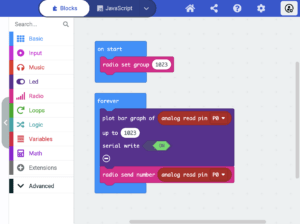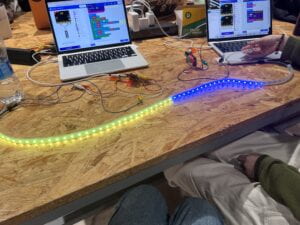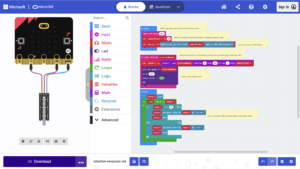Exercise 1: Lilypad
1. Chanel and I first connected the linear potentiometer we made in week 2 to the Lilypad and then read the values. (Just as we did last week.)
2. Then we connected the Neopixel to the circuit.

3. Then we downloaded the code and uploaded it.
Exercise 2: Micro: bit
1. Setting up the sensor and the first micro:bit
Circuit:
Code:
Video:
2. Programming the second micro:bit to receive values and use them to control the neopixels.
(We first built the circuit, uploaded the given code, and later made some adjustments on the code to see the different effects.)
Circuit:
(Original)

(Adjusted)
Code (Adjusted Ver):
Video:
(Original)
(Adjusted)
Assignment 3:
Q: Investigate how animals/plants communicate with each other and write about an interesting form of communication that you could use in a wearable to communicate with others. How do you imagine you could use what you learned today for a wearable?
First of all, I would like to thank this assignment for reminding me of the task my mom gave me to water her flowers before she went on a trip for New Year’s Eve, otherwise, I really forgot about it!
Through the video and the links given, I learned that plants not only communicate with each other through smells and changes in form but also by making sounds. I found this interesting because these sounds are very small, and to understand the message being communicated, you need to amplify these sounds. Plants sound different when they are dehydrated than when they are well-watered. This reminds me of how in the human world—when we are hungry, our stomachs will growl; when we sit in a place for a long time and are tired, our breathing will become heavier; when we are impatient with something, we will tap our fingers on the table, etc.; these are tiny signals that we don’t easily notice or even want to be ignored by other people, but the hunger, the tiredness, or the impatience should not be ignored in and of itself! But hunger, fatigue, or impatience should not be ignored in and of themselves. On the contrary, these signals should be amplified, as they reflect a normal human condition.
In light of what I learned in the third week of class, and the interesting and subtle communication between plants and animals, I had this idea, called “Let your boss know how tired you are” (Aka: Smart Workingwear): Often, when a person is engaged in a task, his or her tiredness is easily ignored by themselves and their boss, just like a plant that is dehydrated and makes a sound, but it is too subtle to be heard by anyone else. We should have something like a pressure sensor, a tension sensor, and a badge that can be worn on the back like a neopixel (but in a smaller ver). The pressure sensor could be attached to the employee’s wrist, and when the hand is typing, the wrist touches the computer, and pressure is generated. Tension sensors can be attached to the employee’s neck and seat back, creating tension when the employee looks down and works, and the accumulative tension and pressure values are reflected on the neopixel badge behind the back. The badge is invisible to the employee, but visible to colleagues and the boss, so that others can remind him to take a break, and the boss can arrange the working hours and intensity more reasonably.
Leave a Reply